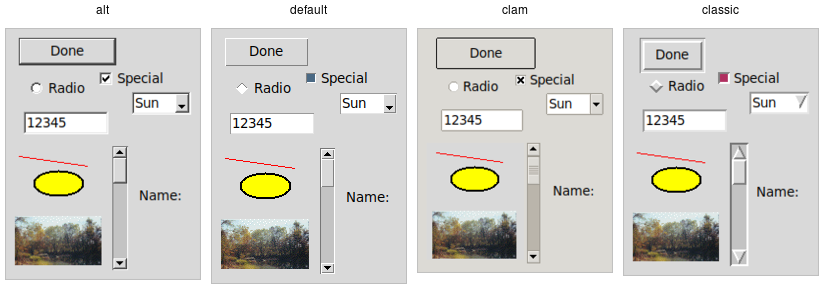Using Existing Themes
Before delving into the weightier matters of tastefully and selectively modifying and applying styles to improve the usability of your application and cleanliness of your code, let's deal with the fun bits: using existing themes to completely reskin your application.
Themes are identified by a name. You can obtain the names of all available themes:
#![allow(unused)] fn main() { let names = tk.theme_names()? .iter() .fold( String::new(), |acc,name| format!( "{} {}", acc, name )); println!( "{}", names ); // clam alt default classic }
 |
|---|
| Built-in themes. |
Besides the built-in themes (alt, default, clam, and classic), macOS
includes a theme named aqua to match the system-wide style, while Windows
includes themes named vista, winxpnative, and winnative.
Only one theme can be active at a time. To obtain the name of the theme currently in use, use the following:
#![allow(unused)] fn main() { let theme = tk.theme_in_use()?; println!( "{}", theme.name ); // aqua }
This API, which was originally targeted for Tk 8.6, was back-ported to Tk 8.5.9. If you're using an earlier version of Tk getting this info is a bit trickier.
Switching to a new theme can be done with:
#![allow(unused)] fn main() { new_theme.theme_use()?; }
What does this actually do? Obviously, it sets the current theme to the indicated theme. Doing this, therefore, replaces all the currently available styles with the set of styles defined by the theme. Finally, it refreshes all widgets, so they take on the appearance described by the new theme.
Third-Party Themes
With a bit of looking around, you can find some existing add-on themes available for download. A good starting point is https://wiki.tcl-lang.org/page/List+of+ttk+Themes.
Though themes can be defined in any language that Tk supports, most that you will find are written in Tcl. How can you install them so that they are available to use in your application?
As an example, let's use the "awdark" theme, available from https://sourceforge.net/projects/tcl-awthemes/. Download and unzip the awthemes-*.zip file somewhere. You'll notice it contains a bunch of .tcl files, a subdirectory i containing more directory with images used by the theme, etc.
One of the files is named pkgIndex.tcl. This identifies it as a Tcl package,
which is similar to a module in other languages. If we look inside, you'll see a
bunch of lines like package ifneeded awdark 7.7. Here, awdark is the name of
the package, and 7.7 is its version number. It's not unusual, as in this case,
for a single pkgIndex.tcl file to provide several packages.
To use it, we need to tell Tcl where to find the package (via adding its
directory to Tcl's auto_path) and the name of the package to use.
#![allow(unused)] fn main() { let path = std::path::Path::new( "/full/path/to/awthemes-9.3.1" ); tk.package_load( "awdark", path )?; }
If the theme is instead implemented as a single Tcl source file, without a
pkgIndex.tcl, you can make it available like this:
#![allow(unused)] fn main() { let path = std::path::Path::new( "/full/path/to/themefile.tcl" ); tk.source( path )?; }
You should now be able to use the theme in your own application, just as you would a built-in theme.